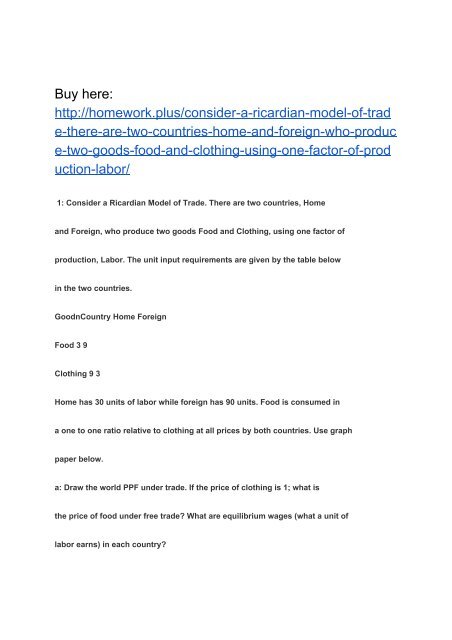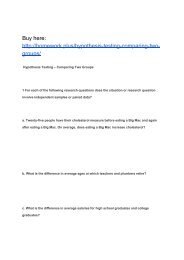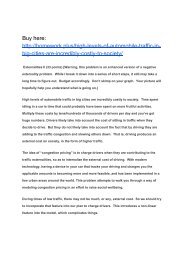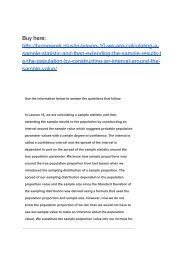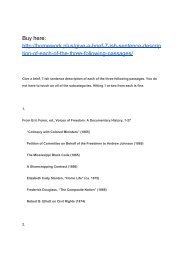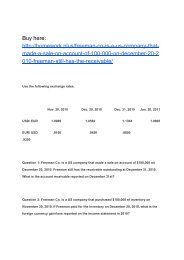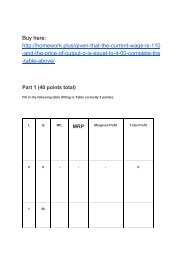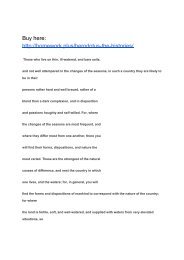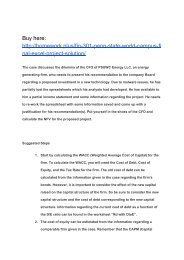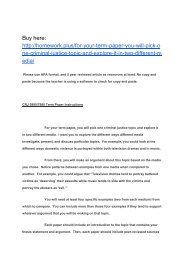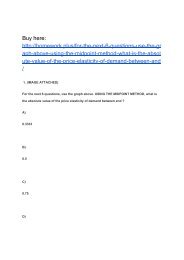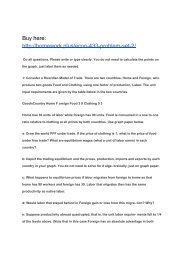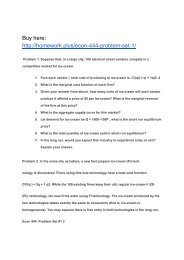Consider a Ricardian Model of Trade. There are two countries, Home and Foreign, who produce two goods Food and Clothing, using one factor of production, Labor
Consider a Ricardian Model of Trade. There are two countries, Home and Foreign, who produce two goods Food and Clothing, using one factor of production, Labor
Consider a Ricardian Model of Trade. There are two countries, Home and Foreign, who produce two goods Food and Clothing, using one factor of production, Labor
You also want an ePaper? Increase the reach of your titles
YUMPU automatically turns print PDFs into web optimized ePapers that Google loves.
Buy here:<br />
http://homework.plus/consider-a-ricardian-model-<strong>of</strong>-trad<br />
e-there-<strong>are</strong>-<strong>two</strong>-<strong>countries</strong>-home-<strong>and</strong>-foreign-<strong>who</strong>-produc<br />
e-<strong>two</strong>-<strong>goods</strong>-food-<strong>and</strong>-clothing-<strong>using</strong>-<strong>one</strong>-<strong>factor</strong>-<strong>of</strong>-prod<br />
uction-labor/<br />
1: <strong>Consider</strong> a <strong>Ricardian</strong> <strong>Model</strong> <strong>of</strong> <strong>Trade</strong>. <strong>There</strong> <strong>are</strong> <strong>two</strong> <strong>countries</strong>, <strong>Home</strong><br />
<strong>and</strong> <strong>Foreign</strong>, <strong>who</strong> <strong>produce</strong> <strong>two</strong> <strong>goods</strong> <strong>Food</strong> <strong>and</strong> <strong>Clothing</strong>, <strong>using</strong> <strong>one</strong> <strong>factor</strong> <strong>of</strong><br />
<strong>production</strong>, <strong>Labor</strong>. The unit input requirements <strong>are</strong> given by the table below<br />
in the <strong>two</strong> <strong>countries</strong>.<br />
GoodnCountry <strong>Home</strong> <strong>Foreign</strong><br />
<strong>Food</strong> 3 9<br />
<strong>Clothing</strong> 9 3<br />
<strong>Home</strong> has 30 units <strong>of</strong> labor while foreign has 90 units. <strong>Food</strong> is consumed in<br />
a <strong>one</strong> to <strong>one</strong> ratio relative to clothing at all prices by both <strong>countries</strong>. Use graph<br />
paper below.<br />
a: Draw the world PPF under trade. If the price <strong>of</strong> clothing is 1; what is<br />
the price <strong>of</strong> food under free trade? What <strong>are</strong> equilibrium wages (what a unit <strong>of</strong><br />
labor earns) in each country?
: Depict the trading equilibrium <strong>and</strong> the prices, <strong>production</strong>, imports <strong>and</strong><br />
exports by each country in your graph. You do not need to solve for it alge-<br />
braically, just on graph paper.<br />
c: What happens to equilibrium prices if labor migrates from foreign to home<br />
so that home has 90 workers <strong>and</strong> foreign has 30. <strong>Labor</strong> that migrates then has<br />
the same productivity as native labor.<br />
d: Would labor that stayed behind in <strong>Foreign</strong> gain or lose from this mi-<br />
gration? Why? (What happens to the budget set <strong>of</strong> a <strong>Foreign</strong> worker? If it<br />
exp<strong>and</strong>s, he must gain.)<br />
e: Suppose productivity abroad quadrupled, that is, the unit labor require-<br />
ments fell to 1/4 <strong>of</strong> the levels above. (Note that in this case <strong>Foreign</strong> has an<br />
absolute advantage in both <strong>goods</strong>.) What happens to world prices? Do home<br />
workers gain from foreign becoming more productive ? Do foreign workers gain<br />
from its productivity improvement? (Comparisons should be relative to the<br />
outcome in part b)<br />
f: Can the PPF when labor is mobile between <strong>countries</strong> lie strictly outside<br />
the world PPF through trade or must it touch it somewhere? Can you give<br />
conditions under which they would touch at some point <strong>and</strong> when they would
not? (Hint: consider what happens when <strong>one</strong> country has an absolute advantage<br />
in both <strong>goods</strong> <strong>and</strong> when this is not the case.)<br />
1<br />
g: Given your answers to part f:, how would you respond to the following<br />
quote:<br />
Given the lack <strong>of</strong> trade barriers today, there <strong>are</strong> orders <strong>of</strong> magnitude more<br />
gains to be had from permitting labor migration than trying to further liberalize<br />
trade.<br />
2. This problem asks you to think <strong>of</strong> issues <strong>using</strong> a relative dem<strong>and</strong> <strong>and</strong> sup-<br />
ply framework more generally. The U.S. <strong>and</strong> the rest <strong>of</strong> the world(ROW) <strong>are</strong><br />
the <strong>two</strong> <strong>countries</strong> in the world. They make <strong>two</strong> <strong>goods</strong>, <strong>Food</strong> (F) <strong>and</strong> Wine (W)<br />
The U.S. exports W:<br />
a: What would be the e¤ect <strong>of</strong> an advertising campaign to promote W in<br />
the ROW? ( Assume that the advertising campaign makes foreigners dem<strong>and</strong><br />
more W relative to F at any relative price.) What would shift? What would<br />
happen to relative prices in the world? Would the U.S. gain or lose from such<br />
advertising if advertising is essentially costless?<br />
b: A war destroys half <strong>of</strong> ROWs productive capacity shrinking its Production
Possibility Frontier (PPF) uniformly inwards for all <strong>goods</strong>. What would shift?<br />
What would happen to prices in the world? Would the U.S. gain or lose? What<br />
about ROW?<br />
c: Suppose that the US consumes mostly wine while the rest <strong>of</strong> the world<br />
consumes mostly food. Would there be a secondary burden <strong>of</strong> foreign aid given<br />
by the US to the ROW? Could the US reduce this secondary burden by giving<br />
its aid in barrels <strong>of</strong> wine? Why/Why not?<br />
3: This question asks you to think <strong>of</strong> how trade can result in gains due to<br />
increasing competition <strong>and</strong> variety. You do not need to do any algebra. Just<br />
draw the graphs needed.<br />
Suppose there <strong>two</strong> <strong>countries</strong> <strong>of</strong> equal size, i.e., both have the same number<br />
<strong>of</strong> people, S. <strong>There</strong> <strong>are</strong> n symmetric rms. Each individual has dem<strong>and</strong> for<br />
the output <strong>of</strong> a representative rm denoted by q(p; P; n) where p is the rms<br />
price, P is the overall average price in the market, <strong>and</strong> n is the number <strong>of</strong><br />
rms. q(p; P; n) is decreasing in p, increasing in P <strong>and</strong> decreasing in n. With S<br />
individuals, the dem<strong>and</strong> for a rm is thus Sq(p; P; n): Let c be marginal cost <strong>and</strong><br />
F be the xed cost <strong>of</strong> <strong>production</strong>. Firms behave monopolistically competitively<br />
<strong>and</strong> choose p to maximize prots taking P <strong>and</strong> n as given. Assume all rms <strong>are</strong>
symmetric so that in equilibrium p = P <strong>and</strong> that rms enter till price equals<br />
average cost, i.e., prots <strong>are</strong> 0.<br />
a: Depict the prot maximizing price charged by a representative rm for<br />
given P <strong>and</strong> n. You do not need to do any algebra. Just to draw dem<strong>and</strong> <strong>and</strong><br />
the prot maximizing price.<br />
b: Show that the maximized prots <strong>of</strong> the rm <strong>are</strong> higher when its costs fall.<br />
(Hint: variable prots <strong>are</strong> also the sum <strong>of</strong> the di¤erence in marginal cost <strong>and</strong><br />
marginal revenue over units <strong>produce</strong>d)<br />
c: As n rises, what happens to the prot maximizing price? What is the<br />
intuition? Call this relation the PP curve.<br />
d: Does an increase (or decrease) in S shift the PP curve? Why?<br />
2<br />
e: As n rises, what happens to output per rm in symmetric equilibrium <strong>and</strong><br />
therefore to average cost? What is the economic intuition here? Call this curve<br />
CC:<br />
f: Does an increase in S shift CC? Why?<br />
g: Depict the equilibrium n <strong>and</strong> p without <strong>and</strong> with trade where trade is just<br />
a doubling <strong>of</strong> S?
h: Explain what the e¤ects <strong>of</strong> trade <strong>are</strong> on prices, vari


